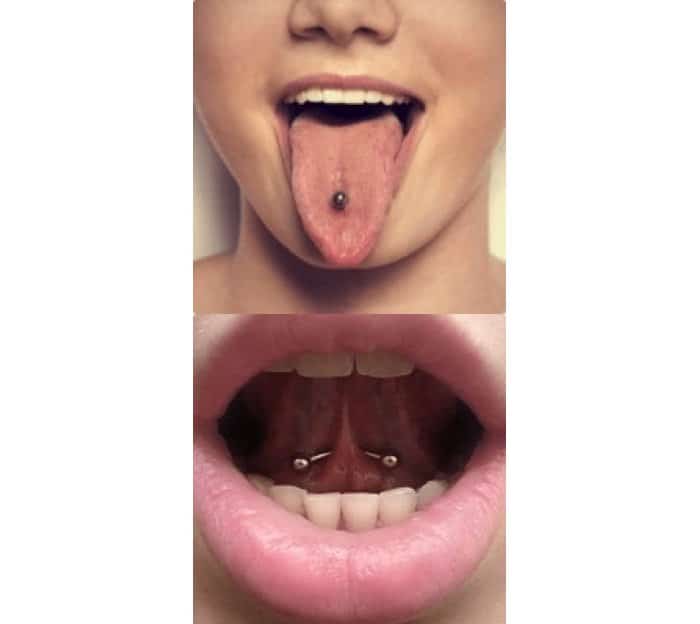Types of Tongue Piercings
The most common type of tongue piercing is a simple straight barbell through the middle of the tongue. But there are multiple types you can get:- Midline
- Frenulum
- Horizontal
- Snake Eyes
Midline
Midline is the safest and most common tongue piercing. It is a single piercing in the center of the tongue, usually decorated with a straight barbell. A variation of this is the side piercing, which is the same, but placed a little to the left or right of the middle.
Frenulum
In your mouth, the frenulum is the skin flap between your tongue and mouth and between your lips and gums. A frenulum piercing goes pierces this skin, it’s sometimes referred to as a web piercing. It is often decorated with a curved or circular barbell.Horizontal
A horizontal piercing goes through the tongue sideways, with a barbell end protruding on either side of the tongue.Snake Eyes
Snake eyes are a tip of the tongue piercing. It’s a version of the horizontal piercing at the tip of the tongue. The ends are intended to look like eyes, giving your tongue a snake-like appearance. They’re sometimes called venom piercings. These are one of the few piercings we do not perform. They have a reputation as a dangerous piercing, so we don’t offer them at any of our locations.Are Tongue Piercings Safe?
As with any piercing, tongue piercing safety relies on going to a safe piercing shop and following piercing aftercare. Midline and frenulum piercings, with proper care, are safe tongue piercings. Both of them minimize potential damage to the tongue’s structure. Horizontal piercings, particularly snake eyes piercings, are potentially more dangerous. They have a high risk of rejection. As well, they can chip or crack teeth. Being horizontal, these piercings go through both tongue muscles, preventing them from moving independently. The potential risks of this are yet uncertain. Another thing to avoid is fake tongue piercing jewellery. This would include clip or magnetic jewellery. The recent trend of making fake tongue piercings out of magnetic balls has lead to multiple choking incidents.How to Prepare for a Tongue Piercing
Taking the care to properly prepare is an important part of a successful piercing routine. All it takes is a few simple do’s and don’ts.Do’s
Do - Research your piercing shop and artist. A safe piercing starts in a safe environment, make sure your shop has a sterile environment and follows safety procedures. Signs like APP membership exemplify exceptional safety practices.
You can also look through your artist’s portfolio for example sof the work they’ve done.
Do - Eat before your piercing. We usually advise eating within 2 hours of your piercing. Proper nutrition will help recovery.
Do - Schedule a day and/or time you can get plenty of rest. You improve your healing by allowing time for rest and recovery.
Don’t’s
Don’t - Drink alcohol before a piercing. If you’re anxious it can be tempting to cowboy up and have some drinks to dull the senses or reduce nerves. But this is dangerous. For one, it can actually make the piercing more painful. As well, it makes it hard for the blood to coagulate, so healing is slower.
Don’t - Get pierced if you’re sick. It’s okay to reschedule if you aren’t feeling well, it’s better for you and it’s better for us. There is a higher risk of rejection or infection when you are sick. As well, you put your piercer at risk of getting sick - be nice to your piercing artist.
Does Piercing Your Tongue Hurt?
No piercing is pain free, and the tongue is no exception. On the pain scale, the tongue hurts more than earlobe piercings and less than ear cartilage piercings. It may cause a wince, but is pretty tolerable. Any residual pain shouldn’t last more than a day. This is in pretty stark contrast to Aztec tongue piercing rituals, where they would cause deliberate pain as a sign of bravery and a sacrifice to their gods. Modern piercing methods, however, are made to minimize pain and maximize safety.
This is in pretty stark contrast to Aztec tongue piercing rituals, where they would cause deliberate pain as a sign of bravery and a sacrifice to their gods. Modern piercing methods, however, are made to minimize pain and maximize safety.
What Can I Eat After?
Most people are able to eat regular foods after a tongue piercing. Still, in the first few days it’s best to go with foods that won’t irritate the piercing. Soft, healthy foods are generally best. Whereas sour, hot, hard, spicy, and sticky foods are best avoided. Some foods that are easy to eat after a tongue piercing are:
Some foods that are easy to eat after a tongue piercing are:
- Ice cream
- Smoothies
- Noodles
- Fish
- Salad
- Soup
- Pizza
- Fruit (avoid acidic fruits like citrus for the first few days)
What to Expect After a Tongue Piercing?
Before getting pierced it’s good to know what you can expect after. That way you can tell the difference between normal recovery response and a potential concern. Talk to your piercer or doctor if you have an abnormal reaction.Normal - Swelling is normal for as long as two weeks. Usually reducing after the first few days.
Abnormal - Excessive swelling after 4 days or swollen throat.
Normal - Mild discomfort, particularly if talking or eating a lot.
Abnormal - Extreme pain, blistering, burning, redness, or bleeding. This may be the result of an allergy.
Normal - A “tingly” sensation.
Abnormal - Numbness.
Normal - Feeling tired. You immune system is reacting to the piercing, which can wear you down for a few days.
Abnormal - Fever, nausea, vomiting. While you may feel rundown, you shouldn’t actually get sick.


